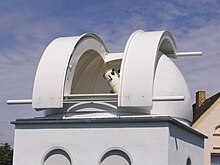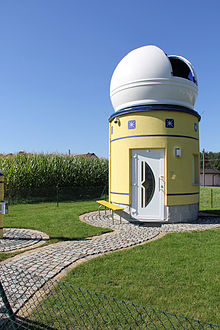Private observatory
Private observatories are astronomical observation stations of various types that are operated by private individuals. This is where they differ from professional research observatories or public observatories that are maintained and operated by scientific institutions, public bodies or associations.
In the case of sophisticated buildings, it is essentially a question of setting up one or more telescopes permanently so that they are always ready for observation. Weather protection, good visibility and the stability of the substructure have priority. Observation areas such as roof observatories (special roof structures, roof terraces) or outdoors, where the telescope is only set up for use and then brought into the house, are less expensive .
The rooms are accordingly very different and range from larger balconies, skylights or terraces in the attic to sliding roofs in the ridge of a house to separate domed buildings in the garden or other open spaces. Simple wooden garden sheds with sliding roofs are very common .
The instruments are just as different. It ranges from small lens telescopes on light mounts that weigh only a few kilograms, to the widespread eight-inch telescope (portable mirror telescope with a 20 cm aperture) to mirror telescopes with mirror diameters of up to one meter. Computer controls, special devices for solar observation or spectroscopy, and extensive equipment for astrophotography are increasingly being used for this purpose .
Activity of private observatories
The self-set tasks of amateur astronomers range from the simplest sky observations and regular observation of the sun, moon or planets to photography of nebulae , orbital measurement of earth satellites and shooting stars or the search for new comets to the monitoring of variable stars and other research-supporting work. Some observatories are also dedicated to celestial public relations or offer private star tours on Astronomy Day . Worldwide, private observatories have already discovered thousands of asteroids , comets and even some nova or have contributed to the discovery of lost asteroids.
Some private observatories are temporarily made available as guest observatories, where advanced amateur astronomers are given the opportunity to observe larger telescopes or astrographs . Sometimes such observation stations develop into club or small public observatories - through constant cooperation or through takeover after a death .
Types
Loft conversion
The best view of the sky is usually provided by an observation area at roof height, for which part of the roof is opened by a sliding or folding mechanism. However, some effort is required on site to achieve sufficient stability and vibration damping for the instruments. The advantages of special roof constructions are that they can be easily reached from the house and that the street lighting can be easily shielded. One problem is usually the protection against the wind that increases with altitude.
The platforms for the chimney sweep often found on newer houses are not suitable, even if they are large enough, because the metal transmits every vibration.
Where only a terrace is available, a column can be set in concrete for the telescope or a portable but heavy tripod can be used. The telescope can remain outdoors if it is protected from sunlight and weather by a light tarpaulin or a box that has been pulled over. It is usually useful to have a privacy screen against neighbors and street lighting and, if necessary, a windbreak .
dome
The shape of the hemispherical dome of larger observatories is recreated. The material used for the spherical shell is traditionally wood with an aluminum coating, but recently also fiberglass-reinforced plastic , which leads to a considerable reduction in weight. To seal against rain and snow, special care must be taken with the protruding parts and the dome gap; Flying snow can usually penetrate anyway.
It is also possible to integrate an observatory dome into a family home . For a roof observatory, the upper floor ceiling is designed as a solid concrete ceiling and the telescopic column is pulled out directly from the ceiling, i.e. H. all cast in one piece. The outer walls create the connection to the foundation and divert the vibrations. The circular dome, sheeted with zinc, rests - not rigidly connected to the ceiling plate - floating on dampening neoprene bearings .
Folding roof and roll-top hut
A good and complication-free alternative to the roof extension is a small shelter in the garden. The roof of the specially constructed rectangular room can be removed for observation, either folded outwards or pushed away horizontally on rollers.
With all of the designs mentioned so far, the instruments can remain in the observatory building or room at all times, which means that repeated precise installation of the mount is unnecessary.
Outdoor installation areas
Here, when not in use, the astronomical instruments are either protected from damage by tarpaulin or other simple means, or they are transported to a protected room after use. A foundation or a column is often left in place to make it easier to set up and align the instruments.
The installation site can be a light-protected open space or a flat roof area that is freely accessible .
Well-known private observatories
- The Lilienthal observatory in Lilienthal near Bremen was one of the leading observatories in the world with its instrumental equipment at the beginning of the 18th century.
- The private observatory with the largest amateur telescope in Austria (1 m mirror diameter) is the Purgathofer observatory in Klosterneuburg, built by Rudolf Pressberger .
- The Kuffner Observatory in Vienna, which is now used as a public observatory, was built as a private observatory .
Web links
- http://selbstbau.vdsastro.de/selbstbau-sternwarten/ Self-construction of protective structures for telescopes
- http://www.sternklar.de/gad/private_Sternwarten.htm Directory of observatories in Germany, Austria and Switzerland
- http://www.harpoint-observatory.com Harpoint private observatory
- http://www.inastars.de Inastars Observatory Potsdam
- http://www.haus.thinius.net Single-family house with observatory
- http://www.zudensternen.de/Meine%20Garten%20Sternwarte.html Construction of a simple observatory on a garage
- http://www.privatsternwarte.net Description of a roof observatory
- http://www.privatsternwarte-bischbrunn.de Private observatory in Bischbrunn
- http://www.sternwarte-rotheul.de Rotheul private observatory
- http://www.sternwarte-kletzen.de Construction of an observatory including equipment and construction plans
- http://www.poguntkeweb.de Private observatory in Nordborchen, self-construction and conversion project of a Meade ACF 16 "telescope




